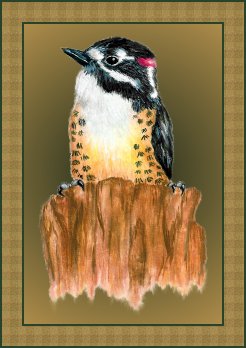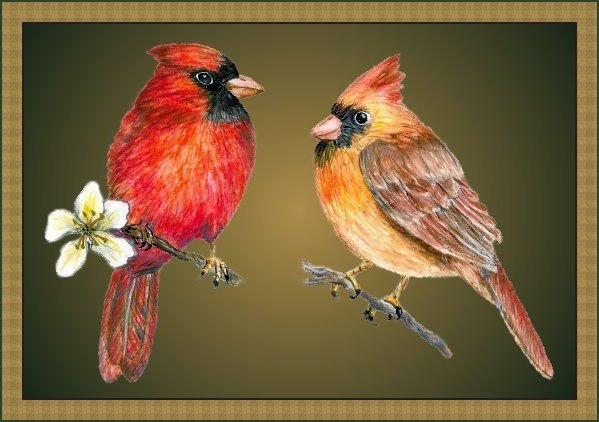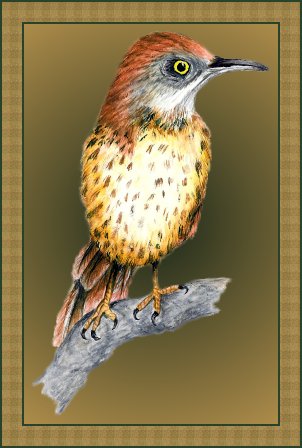

The Birds of Fall are also favorites of mine. I do see these birds at other times of the year, but I don't see much of the Downy Woodpecker until it is cool enough to hang out the suet feeder. I could put it out in the summer, but the heat kind of melts it, and it does attract bears.
 The Downy Woodpecker (Picoides pubescens) is a favorite of mine. They reach a length of 6 3/4 inches long. It is the smallest woodpecker found here. They are easy to tell which sex they are, since only the males have the red feathers on the nape. Downies feed on a variety of insects, and of course they feed on wood-boring insects the most. But they will eat at feeders, especially suet and sunflower seeds. I have found them to be very quiet and cautious when approaching the suet feeder. Downies are found in woods, farmland, suburbs, and parks. They excavate nest cavities in dead wood. Downies lay 4 to 5 eggs that are white in color. They do loud continuous, very rapid pecking on resonant surfaces to announce their territory and attract a mate in the the breeding season. This sound is different from the light taps that are irregularly done to peck for food or excavate for nests. The Downy Woodpecker is very similiar in appearance to the Hairy Woodpecker, except in size. The Hairy Woodpecker is about 9 inches in length.
The Downy Woodpecker (Picoides pubescens) is a favorite of mine. They reach a length of 6 3/4 inches long. It is the smallest woodpecker found here. They are easy to tell which sex they are, since only the males have the red feathers on the nape. Downies feed on a variety of insects, and of course they feed on wood-boring insects the most. But they will eat at feeders, especially suet and sunflower seeds. I have found them to be very quiet and cautious when approaching the suet feeder. Downies are found in woods, farmland, suburbs, and parks. They excavate nest cavities in dead wood. Downies lay 4 to 5 eggs that are white in color. They do loud continuous, very rapid pecking on resonant surfaces to announce their territory and attract a mate in the the breeding season. This sound is different from the light taps that are irregularly done to peck for food or excavate for nests. The Downy Woodpecker is very similiar in appearance to the Hairy Woodpecker, except in size. The Hairy Woodpecker is about 9 inches in length.
The Northern Cardinal (Cardinalis cardinalis) is a favorite of most people and is the state bird of North Carolina. It is also the state bird of several states. It is about 8 1/2 inches in length. It will readily come to feeders where it prefers sunflower seeds, safflower seeds and cracked corn. Cardinals feed by hopping around on the ground, getting food from low shrubs and trees. They eat insects, spiders, wild fruits, berries, and weed seeds. Cardinals are found in shrubs near open areas, woods, parks, and yards. They build nests of twigs, bark strips, vines, leaves, rootlets, and line them with fine grass and hair. Cardinals place the nests in dense shrubbery or in branches of small trees about 1 to 15 feet off the ground. They lay 2 to 5 eggs that are white with dark marks. Breeding Cardinals will do mate-feeding, where the male picks up a seed and hops over to the female to give her the seed. Their beaks will briefly touch as she takes the seed. This can occur as much as 4 times a minute while feeding. Mate-feeding will occur from breeding to egg-laying to incubation phase.

 The Belted Kingfisher (Ceryle alcyon) is found along sides of waterways that feature banks. They are about 13 inches in length. They eat fish, amphibians, reptiles, and insects. They stay on perches overlooking water where they may spot food. They will fly over water with their heads slightly raised and will fish by swooping close to the surface, dipping in for the fish. Kingfishers will also fly to a great height and then plunge into the water to grab a fish. They are the only kingfisher outside of Texas and are found near rivers, lakes, and coastal bays. Kingfishers nest in tunnels that they excavate in a vertical bank. The excavation is done with their bills, alternating with one kicking out the dirt excavated by the other. The tunnel is 3 to 4 inches in diameter, down 1 1/2 feet from the top of the bank, but the tunnel is from 3 to 15 feet in length! The nest is a spherical chamber at the end of the tunnel where they lay 5 to 7 white eggs. The Belted Kingfisher (Ceryle alcyon) is found along sides of waterways that feature banks. They are about 13 inches in length. They eat fish, amphibians, reptiles, and insects. They stay on perches overlooking water where they may spot food. They will fly over water with their heads slightly raised and will fish by swooping close to the surface, dipping in for the fish. Kingfishers will also fly to a great height and then plunge into the water to grab a fish. They are the only kingfisher outside of Texas and are found near rivers, lakes, and coastal bays. Kingfishers nest in tunnels that they excavate in a vertical bank. The excavation is done with their bills, alternating with one kicking out the dirt excavated by the other. The tunnel is 3 to 4 inches in diameter, down 1 1/2 feet from the top of the bank, but the tunnel is from 3 to 15 feet in length! The nest is a spherical chamber at the end of the tunnel where they lay 5 to 7 white eggs.
 This is the Eastern Screech Owl (Otus asio), and it is about 8 1/2 inches in length. It is brownish in color, but has gray or red morphs. It is the only small owl in the Eastern United States with ear tufts. The tufts can be lowered and hidden, making them appear to be another kind of owl. The Screech Owl eats mice, insects, amphibians, and birds. It can be seen in cities feeding on insects that are attracted to streetlights. They are found in woods, swamps, parks, and suburbs. Screech Owls nest in tree cavaties, old woodpecker holes, or a birdhouse. They do not add any nesting material. They lay 3 to 5 eggs that are white. Their territory is only the area right around the nest site. The male will feed the female while she incubates the eggs. When fledging, the young owls cannot fly well and may use their beaks and talons to crawl out of the nest and up to a branch until they are strong enough to fly. The same pair of owls may occupy a nesting site for 7 years or more. This is the Eastern Screech Owl (Otus asio), and it is about 8 1/2 inches in length. It is brownish in color, but has gray or red morphs. It is the only small owl in the Eastern United States with ear tufts. The tufts can be lowered and hidden, making them appear to be another kind of owl. The Screech Owl eats mice, insects, amphibians, and birds. It can be seen in cities feeding on insects that are attracted to streetlights. They are found in woods, swamps, parks, and suburbs. Screech Owls nest in tree cavaties, old woodpecker holes, or a birdhouse. They do not add any nesting material. They lay 3 to 5 eggs that are white. Their territory is only the area right around the nest site. The male will feed the female while she incubates the eggs. When fledging, the young owls cannot fly well and may use their beaks and talons to crawl out of the nest and up to a branch until they are strong enough to fly. The same pair of owls may occupy a nesting site for 7 years or more.
 This bird is the Brown Thrasher (Toxostoma rufum) and at around 11 1/2 inches in length is a pretty large bird. The Brown Thrasher has a long tail and slightly downcurved bill. They feed on the ground and use this bill to toss aside leaves to search in the leaves for food. They eat insects, lizards, snakes, tree frogs, and wild berries. They are found in this area (western North Carolina) in thickets and shrubs in open areas and at wood edges. They make nests of twigs, grass, dead leaves, grapevine, and paper and line the nests with grasses. They will make the nests on the ground, in a bush, in vines, or in trees up to 15 feet off the ground. Brown Thrashers lay 2 to 6 eggs that are light blue in color with fine dark marks. They, like mockingbirds and catbirds, are members of the Mimidae (or mimic thrushes) family and can mimick the songs and calls of other birds. One way to tell the Brown Thrasher from a mockingbird or catbird by sound, is that catbirds repeat phrases once, Brown Thrashers twice, and mockingbirds 3 or more times. It is the only Thrasher throughout most of the East. The Brown Thrasher is also the state bird of Georgia, where I was born. This bird is the Brown Thrasher (Toxostoma rufum) and at around 11 1/2 inches in length is a pretty large bird. The Brown Thrasher has a long tail and slightly downcurved bill. They feed on the ground and use this bill to toss aside leaves to search in the leaves for food. They eat insects, lizards, snakes, tree frogs, and wild berries. They are found in this area (western North Carolina) in thickets and shrubs in open areas and at wood edges. They make nests of twigs, grass, dead leaves, grapevine, and paper and line the nests with grasses. They will make the nests on the ground, in a bush, in vines, or in trees up to 15 feet off the ground. Brown Thrashers lay 2 to 6 eggs that are light blue in color with fine dark marks. They, like mockingbirds and catbirds, are members of the Mimidae (or mimic thrushes) family and can mimick the songs and calls of other birds. One way to tell the Brown Thrasher from a mockingbird or catbird by sound, is that catbirds repeat phrases once, Brown Thrashers twice, and mockingbirds 3 or more times. It is the only Thrasher throughout most of the East. The Brown Thrasher is also the state bird of Georgia, where I was born.

References
- Please note that birds are not drawn to scale, but I have tried to get them as close as possible.
- "The Sibley Guide to Birds" by David Allen Sibley (It doesn't get better than this book and I can't imagine the work in the artwork!)
- "North American Wildlife" published by Reader's Digest (Best all-around guide that includes everything, including so many plants!)
- "Stokes Field Guide to Birds" Eastern Region by Donald & Lillian Stokes
- "Eastern Birds - An Audubon Handbook" by John Farran, Jr.
- The cat is kept in at all times so that she can enjoy the birds, the birds can enjoy the feeders, and no one gets hurt!
Links
The Birds Nest
Birds of Winter
Birds of Spring
Birds of Summer
Birds of Fall
Home
Site Map
Email at: dh @ naturehaven.com
(Take out the spaces and this email address will work!)
|

|